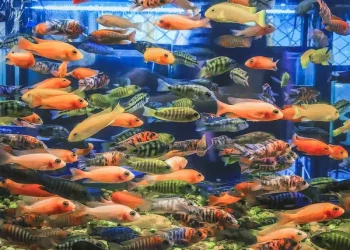In the realm of aquatic creatures, lungfish stands out as one of the most intriguing and distinctive species. These remarkable fish have captured the attention of scientists and nature enthusiasts for their ability to survive in environments that undergo extreme changes, such as droughts. Today, we will explore the extraordinary characteristics and adaptations that make lungfish so unique. From their primitive lungs to their ability to aestivate and their ancient lineage, we will delve into the world of lungfish and uncover the secrets that make them a true marvel of evolution.
Ancient Lineage
Lungfish belong to an ancient group of fish called Sarcopterygii, which dates back over 380 million years. This lineage represents one of the closest relatives to the first vertebrates that ventured from water to land, making lungfish a living link to the early evolutionary history of terrestrial life. Their evolutionary significance and resemblance to our ancient ancestors make them captivating subjects for scientific study.
Primitive Lungs
One of the most distinctive features of lungfish is their ability to breathe air using primitive lungs. While most fish rely solely on gills for respiration, lungfish possess a unique adaptation that allows them to breathe atmospheric oxygen. This adaptation proves invaluable when they inhabit water bodies prone to drought or when oxygen levels in the water become low. Lungfish gulp air from the water’s surface, filling their lungs, and extracting oxygen before returning to the water to release carbon dioxide. This dual respiratory system is an extraordinary trait that sets them apart from other fish species.
Aestivation: Surviving Extreme Conditions
Lungfish have developed a remarkable survival strategy known as aestivation, enabling them to endure harsh environmental conditions, including prolonged droughts. During dry periods, when their aquatic habitats shrink or completely dry up, lungfish dig burrows in the mud or substrate, secreting a mucous cocoon around themselves to retain moisture. They enter a state of dormancy, drastically reducing their metabolic rate and conserving energy until favorable conditions return. This remarkable ability to aestivate allows lungfish to survive in environments where other species would perish.
Feeding Habits and Diet
Lungfish exhibit diverse feeding habits, depending on the species and their available food sources. Some species are herbivorous, feeding on aquatic vegetation and algae, while others are opportunistic predators, consuming small invertebrates, insects, and even small fish. This adaptability in diet allows lungfish to thrive in various ecological niches.
Unique Reproductive Strategies
Lungfish possess unique reproductive strategies, varying among different species. Some species lay eggs in underwater nests or burrows, guarding and caring for them until they hatch. Other species exhibit internal fertilization, with the male transferring sperm directly to the female’s reproductive tract. After fertilization, the female may lay eggs or give birth to live young, depending on the species. The intricate reproductive behaviors of lungfish contribute to their evolutionary success and survival in diverse habitats.
Conclusion
Lungfish stand as fascinating and unique creatures in the world of aquatic life. Their ancient lineage, primitive lungs, ability to aestivate, diverse feeding habits, and distinct reproductive strategies make them a subject of admiration and scientific interest. These remarkable adaptations and survival strategies showcase the resilience and ingenuity of nature’s evolutionary processes. By understanding the exceptional characteristics of lungfish, we gain insight into the complexity and diversity of life on our planet. Lungfish serve as a testament to the extraordinary wonders that can arise through millions of years of evolution and remind us of the remarkable stories hidden within the natural world.
Recommended reading:


























